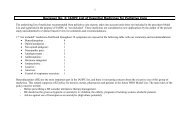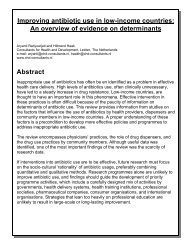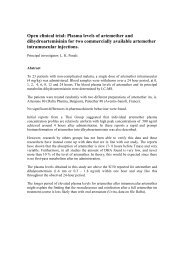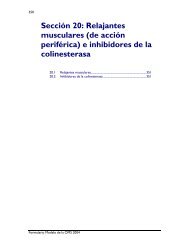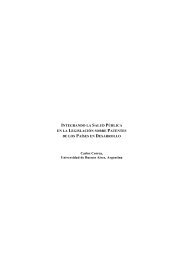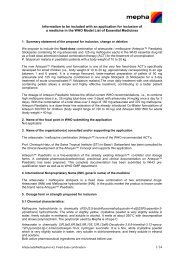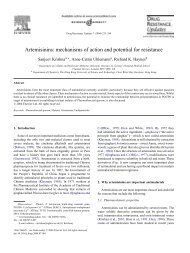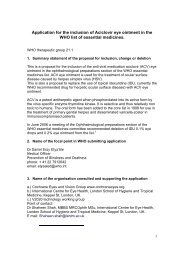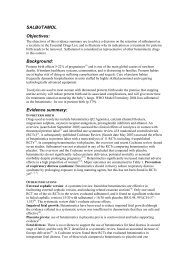SODIUM VALPROATE IN CHILDHOOD EPILEPSY
SODIUM VALPROATE IN CHILDHOOD EPILEPSY
SODIUM VALPROATE IN CHILDHOOD EPILEPSY
Create successful ePaper yourself
Turn your PDF publications into a flip-book with our unique Google optimized e-Paper software.
are the drugs cost and availability and not necessarily efficacy and lack of adverse<br />
effects.<br />
Phenobarbitone is the WHO’s first line anti-epileptic drug in developing countries<br />
where it is the most commonly prescribed anti-epileptic drug. Indeed, in their review<br />
Scott RA et al (7) include a number of studies claiming phenobarbitone to be both<br />
effective and tolerated in patients with epilepsy treated in developing countries.<br />
However, whilst it is cheaper than other agents used frequently in developed<br />
countries (e.g. phenytoin, sodium valproate and carbamazepine), questions have<br />
been raised about its suitability with respect to its efficacy and profile of adverse<br />
effects. Certainly, in Europe and the USA, phenobarbitone is no longer considered a<br />
first line drug due to concerns over its efficacy and short and long-term tolerability.<br />
Despite a lack of hard evidence from individual randomised controlled trials, there is<br />
a strong recommendation in Europe and the USA that sodium valproate should be<br />
considered as a first line treatment in generalised, partial and other epilepsies.<br />
9. Treatment details (dosage regimen, duration; reference to existing<br />
WHO and other clinical guidelines; need for special diagnostic or<br />
treatment facilities and skills)<br />
For oral administration an initial dose for infants and children from 1 month to 12<br />
years of age is 5-7.5mg/kg/dose given twice daily. This can be gradually increased,<br />
as necessary, to a usual maintenance dose of 12.5-15mg/kg/dose twice daily.<br />
Clinical chemistry and haematological parameters should be measured if the dose<br />
exceeds 20mg/kg/dose twice daily (9) .<br />
In those aged 12-18 years, an initial oral dose of 300mg/dose twice daily is<br />
suggested increasing in steps of 200mg daily at 3 day intervals to a usual<br />
maintenance dose of 0.5-1g/dose twice daily. The maximum recommended dose is<br />
1.25g/dose twice daily (9) .<br />
Plasma valproate concentrations are not a useful index of efficacy therefore routine<br />
monitoring is unhelpful.<br />
10. Summary of comparative effectiveness in a variety of clinical<br />
settings<br />
The most likely mode of action is the potentiation of the inhibitory action of gamma<br />
amino-butyric acid through an action on the further synthesis or further metabolism of<br />
GABA (8) .<br />
There is a paucity of studies on the comparative efficacy of anti-epileptic drugs in<br />
specific epilepsy syndromes. In newly diagnosed epilepsies, across age groups and<br />
all seizure types, several randomised controlled trials of carbamazepine, sodium<br />
valproate, clobazam, phenytoin and phenobarbitone show they are effective but fail<br />
to identify significant differences in efficacy between these medications.<br />
The potential adverse effects of anti-epileptic drugs should be a major determinant of<br />
the choice of drug in the individual child.<br />
In 1996, de Silva M et al (10) reported on a randomised comparative trial in children. In<br />
this long-term, prospective trial, the efficacy and tolerability of phenobarbitone,<br />
phenytoin, carbamazepine and sodium valproate were compared in 167 children<br />
aged 3-16 years with at least 2 previously untreated tonic-clonic or partial seizures.<br />
Sodium valproate page 4



